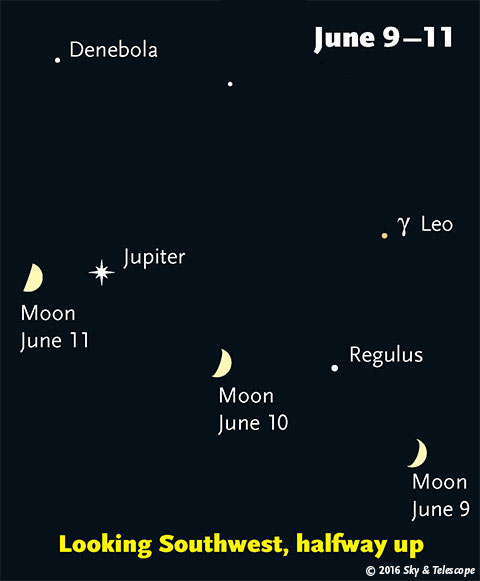
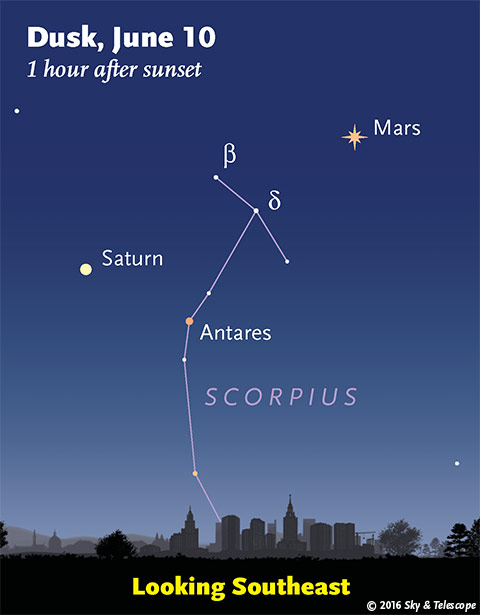
Friday, June 10
• This evening the Moon poses partway between Jupiter to its upper left and fainter Regulus to its right, as shown here.
• Turn binoculars or a telescope on Jupiter, and you'll find 5th-magnitude Chi Leonis some 0.1° to its north, looking like an out-of-place Galilean satellite.
Saturday, June 11
• The first-quarter Moon shines fairly close to Jupiter this evening (about 4° to Jupiter's left), as shown here. But looks deceive! Jupiter is 40 times larger in diameter than the Moon, and it's currently 2,100 times farther away.
Sunday, June 12
• The Moon this evening forms a great, nearly straight line with Spica to its left, and Jupiter and Regulus to its lower right.
Monday, June 13
• If you turn your scope to the Moon this evening, also look in on the close double star Gamma Virginis (Porrima), just 2° to 4° to its right (for North America). Gamma Vir's identical components, both magnitude 3.5, are currently 2.5 arcseconds apart. Use high power.
Tuesday, June 14
• Look for 1st-magnitude Spica about 4° below the Moon this evening (for North America). High above them shines Arcturus.
Wednesday, June 15
• Io reappears from eclipse out of Jupiter's shadow around 10:46 p.m. EDT, good timing for the Eastern time zone. A small telescope will show it gradually swelling into view, just east of the planet.
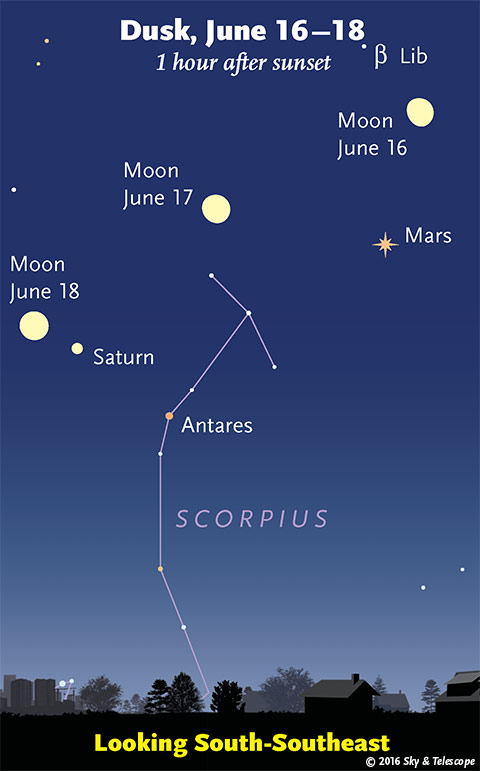
Thursday, June 16
• Mars shines below the gibbous Moon this evening, as shown here; they're fellow travelers across the sky tonight. Never mind that Mars is 200 times farther away.
Friday, June 17
• The Moon, Mars, and Saturn make a wide, flattish triangle tonight, as shown here. The longest side connects the two planets, 18° apart.
• A 3-inch telescope will show Saturn's biggest and brightest moon: Titan, magnitude 8.5. Tonight it's west of Saturn, by about four times the length of Saturn's rings. Can you see Titan's orange tint through the moonlight?
Saturday, June 18
• Saturn and the almost-full Moon are 3° to 5° apart (for North America). Saturn is the most distant bright planet, 3,400 times farther away than the Moon tonight.
_________________________
Want to become a better astronomer? Learn your way around the constellations. They're the key to locating everything fainter and deeper to hunt with binoculars or a telescope.
This is an outdoor nature hobby. For an easy-to-use constellation guide covering the whole evening sky, use the big monthly map in the center of each issue of Sky & Telescope, the essential guide to astronomy.
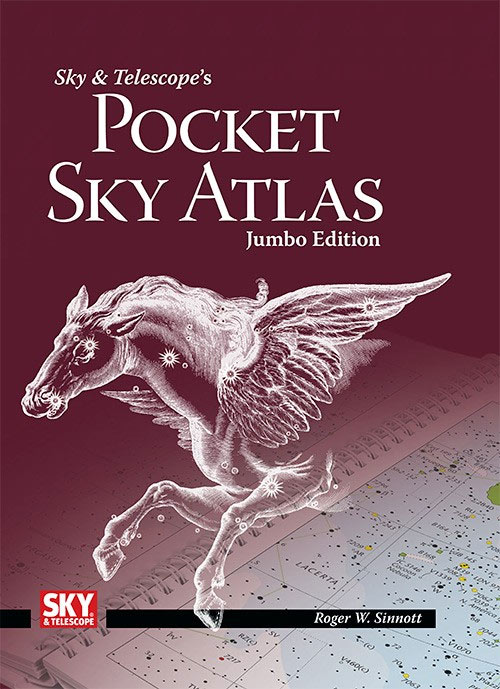
Once you get a telescope, to put it to good use you'll need a detailed, large-scale sky atlas (set of charts). The basic standard is the Pocket Sky Atlas (in either the original or new Jumbo Edition), which shows stars to magnitude 7.6.
Next up is the larger and deeper Sky Atlas 2000.0, plotting stars to magnitude 8.5, nearly three times as many. The next up, once you know your way around, is the even larger Uranometria 2000.0 (stars to magnitude 9.75). And read how to use sky charts with a telescope.
You'll also want a good deep-sky guidebook, such as Sue French's Deep-Sky Wonders collection (which includes its own charts), Sky Atlas 2000.0 Companion by Strong and Sinnott, or the bigger Night Sky Observer's Guide by Kepple and Sanner.
Can a computerized telescope replace charts? Not for beginners, I don't think, and not on mounts and tripods that are less than top-quality mechanically (meaning heavy and expensive). And as Terence Dickinson and Alan Dyer say in their Backyard Astronomer's Guide, "A full appreciation of the universe cannot come without developing the skills to find things in the sky and understanding how the sky works. This knowledge comes only by spending time under the stars with star maps in hand."
This Week's Planet Roundup
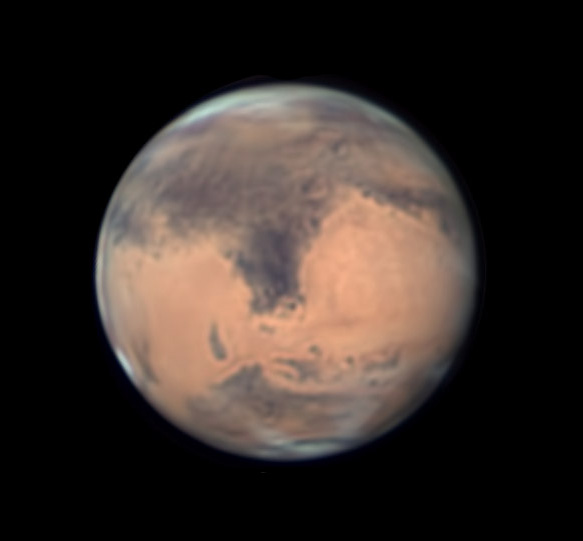
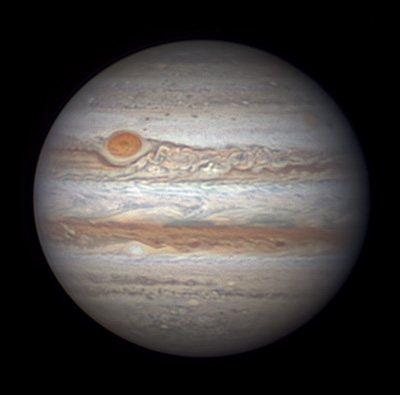
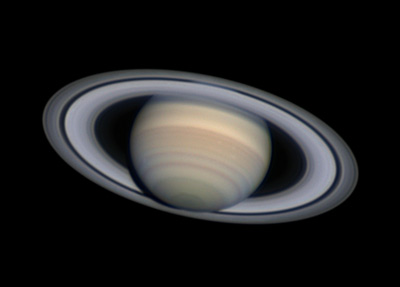
Mercury (about magnitude –0.2) is having a low apparition in the dawn. You can use binoculars to try for it just above the east-northeast horizon 20 or 30 minutes before sunrise.
Venus is hidden in the glare of the Sun.
Mars (magnitude –1.7, in Libra) remains big and bright; it was closest to Earth on May 30th. It's the yellow-orange thing shining in the southeast at nightfall, and due south later at night. After dark, fiery Mars shines nearly as intensely as white Jupiter in the southwest.
Saturn and Antares lie to Mars's east: lower left at dusk. The Mars-Antares-Saturn triangle stands highest in the south around 11 or midnight daylight-saving time. This is when the planets are likely to appear sharpest in a telescope.
Mars shrinks a little this week, from 18.3 to 17.7 arcseconds in diameter. Get your best looks while you can. See our telescopic guide to Mars in the April Sky & Telescope, page 48, or the version online. And set our Mars Profiler for your time and date.
Jupiter (magnitude –2.0, in southern Leo) stands in the southwest during twilight. It moves lower left as the evening progresses. See our telescopic guide to Jupiter in the March Sky & Telescope, page 48.
Saturn (magnitude +0.1, in southern Ophiuchus) the brightest object well east of Mars. To Saturn's lower right is fainter Antares. See our telescopic guide to Saturn in the June Sky & Telescope, page 48.
Uranus (magnitude 5.9, in Pisces) is low in the east just before dawn begins.
Neptune (magnitude 7.9, in Aquarius) is well up in the southeast just before dawn.
__________________________
All descriptions that relate to your horizon — including the words up, down, right, and left — are written for the world's mid-northern latitudes. Descriptions that also depend on longitude (mainly Moon positions) are for North America.
Eastern Daylight Time (EDT) is Universal Time (UT, UTC, or GMT) minus 4 hours.
__________________________
“This adventure is made possible by generations of searchers strictly adhering to a simple set of rules. Test ideas by experiments and observations. Build on those ideas that pass the test. Reject the ones that fail. Follow the evidence wherever it leads, and question everything. Accept these terms, and the cosmos is yours.”
— Neil deGrasse Tyson
 4
4








Comments
June 11, 2016 at 7:08 pm
Hope to catch Io reappearing from eclipse on Wednesday. Pray for clear skies. WV isn't known for a lot of clear nights.
You must be logged in to post a comment.
mary beth
June 14, 2016 at 7:13 pm
Praying! Let me know if you get to see it!
You must be logged in to post a comment.
Rick
June 14, 2016 at 10:12 am
Would sure be nice if this information would be available again outside @ the scope on the mobile android app, (SkyWeek), Has not\will not update events since 06\04\16, & also cannot access menu or nite mode on 2 of 3 devices anymore. Email to dev thru "Play" has received no response, & calling in got me "grocery store" music for 35min on hold.
SOOO disappointed in S & T, this had been my "goto" app outside, hoping a public comment here generates some help & attention.
RickH ~~Ad Astra per Astra~~ 2-Samsung Note5's Android 6.0.1, TabPro12.2\android 5.1.1, Galaxy S3\Android 4.3
You must be logged in to post a comment.
Monica Young
June 14, 2016 at 11:02 am
We apologize for the delay - the app is now updated, though you may need to refresh the page to see the update.
You must be logged in to post a comment.
You must be logged in to post a comment.